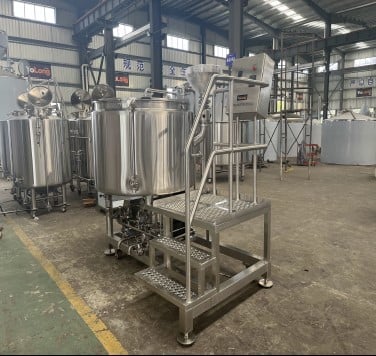Comprehensive Guide to Beer Brewing Equipment
Overview of Beer Brewing Equipment
Brewing beer is both an art and a science. For those eager to dive into the world of homebrewing or even small-scale commercial brewing, understanding the essential equipment is crucial. The right gear can make the difference between a mediocre batch and a brew that impresses even the most discerning palate. This guide explores the various pieces of beer brewing equipment, their purposes, and how to choose the best ones to suit your brewing needs.
Beer brewing equipment encompasses a range of tools, from basic kits for beginners to more sophisticated systems for experienced brewers. Each piece of equipment plays a vital role in the brewing process, ensuring the quality and consistency of your beer.

Types of Beer Brewing Equipment
| Equipment Type | Description |
|---|---|
| Brewing Kettle | A large pot where the wort (unfermented beer) is boiled with hops. Sizes vary, but it’s crucial to have one with at least a 10-gallon capacity for homebrewing. |
| Fermenter | A vessel where the wort is stored while yeast converts sugars into alcohol and CO2. Options include plastic buckets, glass carboys, and stainless steel tanks. |
| Airlock and Bung | Devices that allow CO2 to escape during fermentation while preventing contaminants from entering the fermenter. |
| Hydrometer | A tool used to measure the specific gravity of the wort before and after fermentation, helping to determine alcohol content. |
| Sanitizer | Essential for cleaning all equipment to prevent contamination that could spoil the beer. |
| Bottling Bucket | Used to transfer beer from the fermenter into bottles. Typically equipped with a spigot for easy dispensing. |
| Bottles and Caps | Glass or plastic bottles that hold the finished beer, sealed with caps to maintain carbonation. |
| Bottle Capper | A tool for sealing caps onto bottles, ensuring they are airtight and secure. |
| Thermometer | Used to monitor temperatures during various stages of brewing, crucial for maintaining control over the brewing process. |
| Wort Chiller | A device to quickly cool the wort after boiling, reducing the risk of contamination and haze formation. |
| Mash Tun | A vessel used in all-grain brewing to steep grains in hot water, converting starches into fermentable sugars. |
| Burner | A heat source for boiling the wort, usually propane-fueled for homebrewers. |
The Brewing Process Explained
Brewing beer involves several key steps, each requiring specific equipment and techniques. Here’s a breakdown of the brewing process from start to finish:
1. Mashing
Mashing is the process of combining crushed grains with hot water in a mash tun. This step converts the starches in the grains into fermentable sugars. The temperature and duration of the mash are critical factors that influence the beer’s flavor and body.
2. Boiling
After mashing, the liquid (now called wort) is drained and transferred to the brewing kettle. Here, it is boiled, typically for an hour. During the boil, hops are added at various stages to impart bitterness, flavor, and aroma. The boiling process also sterilizes the wort, ensuring that it is free of unwanted microorganisms.
3. Cooling
Once the boil is complete, the wort needs to be cooled quickly to a temperature suitable for fermentation. This is where the wort chiller comes in handy. Rapid cooling helps prevent contamination and improves the clarity of the beer.
4. Fermentation
The cooled wort is transferred to a fermenter, and yeast is added to start the fermentation process. Over the next several days to weeks, yeast converts the sugars in the wort into alcohol and carbon dioxide. The fermenter should be kept in a cool, dark place to maintain a consistent temperature.
5. Bottling
When fermentation is complete, the beer is siphoned into a bottling bucket, mixed with a small amount of sugar (for carbonation), and then bottled. Bottles are capped and left at room temperature for a few weeks to carbonate.
Equipment Specifications and Considerations
| Aspect | Details |
|---|---|
| Capacity | Equipment capacity varies based on brewing scale. Homebrewers typically use 5-10 gallon setups, while commercial systems range from 1 barrel (31 gallons) to several hundred barrels. |
| Space Requirements | Adequate space is necessary for equipment setup. Homebrewers need a dedicated area, while commercial brewers require larger, often temperature-controlled spaces. |
| Design and Layout | Efficient design and layout facilitate smooth workflow. Consider modular setups for easy expansion, ergonomic designs for user comfort, and compact layouts to maximize available space. |
| Customization Options | Many equipment pieces can be customized to fit specific brewing needs. This includes adjustable burners, personalized fermenters, and bespoke mash tuns. |
Suppliers and Price Range for Beer Brewing Equipment
| Supplier | Price Range | Description |
|---|---|---|
| Northern Brewer | $100 – $1,500 | Offers a wide range of homebrewing equipment and kits, known for quality and excellent customer service. |
| MoreBeer | $50 – $2,000 | Provides equipment for both beginners and advanced brewers, with options for customization. |
| BrewDemon | $60 – $500 | Specializes in fermenters and beginner kits, affordable and easy to use. |
| Blichmann Engineering | $200 – $5,000 | High-end brewing systems and accessories, known for innovation and durability. |
| Spike Brewing | $300 – $3,500 | Stainless steel equipment, offering professional-grade quality for home and small commercial brewers. |
Installation, Operation, and Maintenance of Brewing Equipment
| Stage | Details |
|---|---|
| Installation | Proper setup is crucial. Follow manufacturer instructions, ensure secure connections, and test all equipment before the first brew. |
| Operation | Familiarize yourself with equipment functions. Maintain accurate records of brewing parameters such as temperature and specific gravity. |
| Maintenance | Regular cleaning and sanitization are essential. Periodically check for wear and tear, replace parts as needed, and keep equipment in top condition. |
Choosing a Beer Brewing Equipment Supplier
| Consideration | Details |
|---|---|
| Reputation | Look for suppliers with positive reviews and a history of reliable service. |
| Product Range | Ensure the supplier offers a wide range of products that meet your needs, from beginner kits to advanced systems. |
| Customer Support | Good customer support can assist with installation, troubleshooting, and warranty issues. |
| Customization | Some suppliers offer customizable options to tailor equipment to your specific brewing requirements. |
| Price and Value | Compare prices, but also consider the quality and durability of the equipment. The cheapest option isn’t always the best in the long run. |
Pros and Cons of Different Beer Brewing Equipment Options
| Equipment Type | Advantages | Disadvantages |
|---|---|---|
| Brewing Kettle | Versatile, available in various sizes, essential for boiling wort. | Can be bulky and require a significant heat source. |
| Fermenter | Comes in multiple materials (plastic, glass, stainless steel), essential for fermentation. | Plastic can retain odors, glass is fragile, stainless steel is expensive. |
| Hydrometer | Simple to use, provides essential data for monitoring fermentation. | Requires calibration, fragile. |
| Wort Chiller | Quickly cools wort, essential for reducing contamination risk. | Requires proper sanitization and can be expensive. |
| Bottle Capper | Ensures a tight seal on bottles, maintaining carbonation. | Manual versions can be labor-intensive. |
| Mash Tun | Essential for all-grain brewing, allows for precise control of mash temperature. | Requires more space and investment compared to extract brewing. |
| Sanitizer | Critical for preventing contamination. | Needs careful handling to avoid damaging equipment or beer flavor. |
How to Choose the Right Beer Brewing Equipment
Selecting the right beer brewing equipment depends on several factors:
- Brewing Goals: Are you a hobbyist or planning to go commercial?
- Batch Size: Larger batches require bigger equipment.
- Budget: Consider both initial investment and long-term costs.
- Space: Ensure you have enough room for your setup.
- Experience Level: Beginners might prefer kits, while advanced brewers might want more specialized equipment.

FAQs
| Question | Answer |
|---|---|
| What’s the best equipment for beginners? | Starter kits from reputable suppliers like Northern Brewer or BrewDemon are great for beginners. |
| How do I sanitize my equipment? | Use a no-rinse sanitizer like Star San to ensure all surfaces are free from contaminants. |
| Can I use plastic fermenters? | Yes, but be aware they can scratch easily and retain odors. Glass and stainless steel are more durable options. |
| How often should I replace equipment? | It depends on use and maintenance. Regularly check for signs of wear and replace parts as needed. |
| Is all-grain brewing better than extract brewing? | All-grain offers more control over flavor, but is more complex and time-consuming. Extract brewing is simpler and faster. |
Conclusion
Diving into beer brewing can be incredibly rewarding, whether you’re aiming to enjoy a unique hobby or looking to enter the commercial brewing world. Understanding the equipment and how each piece plays a role in the brewing process is essential for success. With the right tools and knowledge, you can craft beers that stand out and satisfy.
Share this entry
Interested in learning more about Brewing Systems including additional details and pricing information? Please use the form below to contact us!
YOLONG BREWERY EQUIPMENT FAQS
- Commercial Brewery / Craft Brewery / Microbrewery / Nanobrewery
- What is The Difference Between Craft Beer and Industrial Beer?
- The Bespoke Differences In Custom Brewing Systems
- Everything You Need to Know About Kettle Souring
- How to Choose Brewing Equipment for Your business?
- How To Choose The-Best Partner To Build Your Commercial Microbrewing System?
- Two Detection Sensors That You Need To Use In Your Brewhouse System
- Remote Control Applications in Brewing Equipment/How does it work?
- How To Clean Your Brand New Brewery Tanks?

